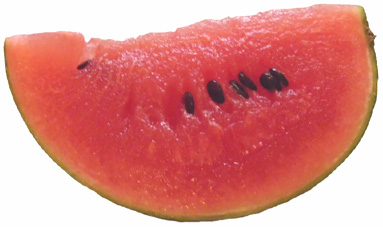...Best of Sicily presents... Best of Sicily Magazine. ... Dedicated to Sicilian art, culture, history, people, places and all things Sicilian. |
by Roberta Gangi | ||
Magazine Index Best of Sicily Arts & Culture Fashion Food & Wine History & Society About Us Travel Faqs Contact Map of Sicily |
In antiquity watermelons were cultivated in the Nile Valley. However, although watermelon seeds have been found in the tombs of Egyptian pharaohs and at archaeological sites in Ethiopia and around the Middle East, the delicious fruit, native to southern Africa, does not appear to have been very widely cultivated north of the Sahara until medieval times. There is some controversy in these matters: Did the ancient Romans know of such crops? Were citrus fruits (for example) cultivated in some parts of their vast Empire? It's really a question of permanency and diffusion. The point is that the continuous cultivation of certain fruits, including watermelons, is identified in the Mediterranean with the centuries following the fall of the Roman Empire. Citrullus Lanatus, which Italians call anguria, is today one of the most common varieties of melon (itself a loose term as most melons are in the genus Cucumis). By the eleventh century the sweet red flesh in a green rind was popular in Sicily and as far away as eastern Asia, where some Japanese farmers grow them in square containers, thus developing a square fruit. Watermelons, which are more than ninety percent water, are a good source of ascorbic acid (Vitamin C), beta carotene, lycopene and potassium. The flesh of some varieties is orange or yellow, and in recent times watermelons of other colors have been bred. Except in Asia, there is surprisingly little legend and folklore surrounding the watermelon. Admittedly, not much can be said about a fruit which is, at best, a complement to other foods. July and August see a great quantity of watermelons sold at stands around Sicily. Not only gelo di melone, but granita and sorbets are flavored with watermelon, which seems the quintessential warm-weather fruit. About the Author: Roberta Gangi has written numerous articles and one book dealing with Italian cultural and culinary history, and a number of food and wine articles for Best of Sicily Magazine. | |
Top of Page |
 Gelo
di melone, a sweet gelatine dessert made from watermelon pulp, has been made in Sicily every summer
for centuries. It is thought to be Arab in origin, but this is uncertain.
What is certain is that watermelons have been raised in Sicily since the
Middle Ages, and that they were introduced by the
Gelo
di melone, a sweet gelatine dessert made from watermelon pulp, has been made in Sicily every summer
for centuries. It is thought to be Arab in origin, but this is uncertain.
What is certain is that watermelons have been raised in Sicily since the
Middle Ages, and that they were introduced by the